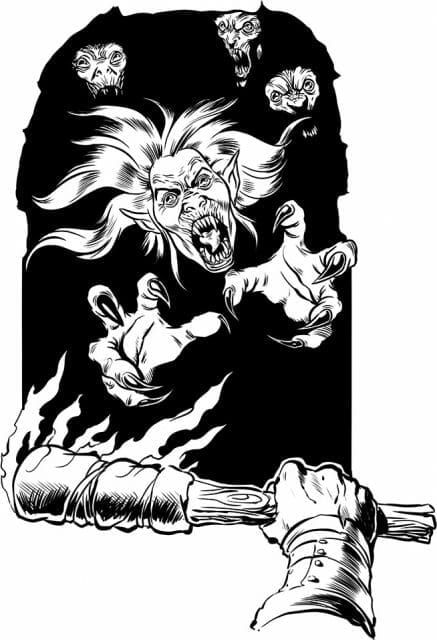Darkvision & Dread: Fear in the Underdark
Using Terror and Horror to Elevate Your Rise of the Drow Campaign
“The stale air clings to your skin like cobwebs. Moisture drips rhythmically from unseen stone high above. Your footsteps echo too loudly, bouncing off the cavern walls with every nervous shuffle. Then—something stirs in the shadows ahead. A breath. A soundless movement. A flash of green eyes.
‘I have darkvision,’ a player mutters.
And just like that, the tension snaps like a frayed rope.”
If you’ve ever tried running a suspenseful scene in the Underdark only for a single sentence to suck the oxygen from the moment, you’re not alone.
The (Literal) Problem with Darkvision
As a Game Master in the Rise of the Drow or After the Fall campaigns, you have an abundance of atmospheric tools at your disposal. Vast caverns echo with unseen dangers, fungal forests whisper with alien life, and the architecture of fallen Holoth stretches like the bones of a dying god. But then—“I have darkvision.”
Suddenly the looming shape isn’t a mystery. The trap becomes just another footnote in a Perception check. The creeping dread vanishes in a flood of grayscale clarity. So how do you reclaim fear in a world where every adventurer seems born with built-in night goggles?
Let’s explore how the tools of terror and horror can turn even the most light-adapted party into paranoid, wide-eyed wrecks.
Know Thy Fear: Terror vs. Horror
Before you dive deeper than Tolgorith Tower’s deepest vault, it helps to know the difference between terror and horror:
- Terror is the anticipation of something dreadful.
- Horror is the gut-wrenching moment when it’s fully revealed.
As Gothic scholar Devendra Varma once put it: “Terror is the smell of death. Horror is stumbling against the corpse.”
In a Rise of the Drow or After the Fall game, that difference is everything. You want to layer terror across every footstep, every shadow, every moment of silence. And then, at the worst possible time, unleash the horror.
Terror in the Deep: Building Dread in Aventyr’s Underworld
The Aventyr Underworld is a living nightmare of jagged caverns, chittering spider-kin, psychic fungi, and the remnants of a shattered Drow empire. Whether the characters are creeping through a mycelial trench or navigating the ruins of Hopeholme, fear is just one moment away—if you play it right.

Here are some techniques to instill terror even in the presence of darkvision:
- Use Sound, Smell, and Touch:
Instead of what they see, describe what they hear: a skittering echo too slow to be an insect. A breath that doesn’t belong to anyone in the party. A sudden drop in temperature. You’re building a sense that something is near, but not revealing what. - Implant Paranoia:
When the party rests, whisper something only one character hears. Maybe a laugh. Maybe their own name. Was it real? You won’t say.
(Optional: It wasn’t.) - Leverage Our d100 Tables:
Sprinkle in entries from d100 Underdark Events or d100 Hopeholme Encounters. The more surreal, the better. A tower of bones lit by glowing fungus. A cage holding something that’s almost a drow child. Footsteps that follow but leave no prints.
These tools work best when nothing actually happens. The terror is in the maybe.
Horror in the Underdark: The Moment the Mask Drops
Eventually, the curtain must fall.
Horror is the moment the players realize that what’s been stalking them isn’t just real—it’s worse than they imagined. And it’s their fault.
In After the Fall, this might be the moment the characters find their missing House sibling in a Coalition lab, drugged and transformed. Or when the whispers in their heads become commands—and they realize the Vidrefacte is watching.
Use horror when it matters:
- Gory Set Pieces:
A drider feeding its young with a still-living prisoner. A fallen temple where the statues bleed. Don’t overuse this, or it becomes gore-porn. Save it for impact. - NPC Consequences:
Did they leave a Hopeholme rebel behind? Show them what happens to traitors. A warning nailed to a wall. Or better yet—have the NPC escape… changed. - Personal Fears:
Did someone take the “Marked by the Spider Queen” background? Play with it. Her eyes in every reflection. Webs forming on their skin when they sleep.
Horror lingers because it sticks. It marks the character, or the world, or the mind of the player. And the best horror? It comes from their own choices.
Final Torchlight: Fear That Lasts
While your drow or drider characters may see through the darkness, they’ll never see everything. Use that to your advantage.
In Rise of the Drow and After the Fall, Aventyr’s Underworld is more than tunnels and trolls—it’s a living ecosystem of fear. From the whispering caverns to the crumbling grandeur of Holoth, you have everything you need to terrify and horrify in equal measure.
Ready to Begin?
Delve deeper with the
👉 Rise of the Drow Collector’s Edition
Packed with twisted drow lore, new rules for subterranean survival, and a bestiary that will haunt your dreams, it’s the perfect Underdark toolkit.
Darkness Rises, and the Time is Now…
Align with House AAW and be the first to uncover new quests, ancient powers, and revelations from the Underworld.


Great post. I love the clarity of terror verse horror!